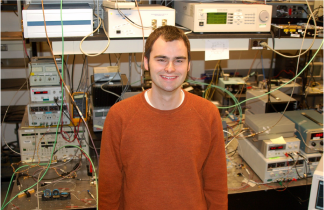
(Above: U.S. President, Barack Obama, following-up his state-of-the-union message at energy technology firm Orion Energy Systems in Manitowok, WI on January 26. Photo from Orion Energy Systems)
Just this past Tuesday, U.S. president, Barack Obama, invoked science and innovation in the State-of-the-Union-Address, as the silver bullet to heal an ailing U.S. economy and crumbling infrastructure. U.S. statesmen and -women alike got up out of their seats repeatedly to give applause for science. Specifically, Mr. Obama, cited three optics-related areas of research to which he will try to allocate U.S. federal funding: 1) biomedical research, 2) information technology, and 3) clean-energy technology. Mr. Obama proposed to send a budget to congress in the next few weeks that would help the U.S. "...reach a level of research and development we haven’t seen since the height of the Space Race." To that aim, CLEO will be hosting contributed papers in these three areas, and if Mr. Obama is successful in his budget requests, perhaps we will be seeing more submissions and exhibitions in these fields in the near-future.
Entire sessions devoted to Obama's first research area, biomedical research, can be found under two-topic categories CLEO:Applications and Technology 1: Biomedical and CLEO: Science and Innovation10: Biophotonics and Optofluidics. The former will contain research already in the clinical-trial stage, whereas the latter will hold emerging research that is "pre-pilot." One of the many sub-categories in these topics includes optical biopsy. The goal of optical biopsy is to diagnose tissue during a medical procedure in vivo with photons rather than extracting it invasively with a knife (to be analyzed later in a lab). This is the aim of many biomedical techniques such as diffuse optical tomography (DOT), optical coherence tomography (OCT), and multiphoton microscopy (MPM). These techniques use light in clever ways to extract information from deep inside tissue which typically scatters away all the light you want. Be sure to attend these sessions for the latest on these and other emerging biomedical techniques.
Sessions for Mr. Obama's second research area, information technology, can be found under topic categories CLEO: Science and Innovation 12: Lightwave Communication and Optical Networking, CLEO Symposium on Quantum Communications, and CLEO: Science and Innovation 9: Components, Integration, Interconnects and Signal Processing. One of the invited talks in the special Symposium on Quantum Communications will be from Masahide Sasaki of NICT, regarding the Tokyo Quantum Key Distribution (QKD) Network. Just this past October, a secure video (a record megabit per second data rate using QKD) was demonstrated over the Tokyo QKD Network at the Updating Quantum Cryptography and Communications conference. Be sure to attend Dr. Sasaki's talk on the current and future state of secure photonic networks.
Finally, sessions regarding Mr. Obama's third area of research, clean-energy technology, can be found under topic categories CLEO: Science and Innovation 15: LEDs, Photovoltaics, and Energy-efficient ("Green") Photonics, and CLEO: Applications and Technology 2: Environment and Energy. One of the sub-categories, photovoltaics, will be discussed at the research stage in the first category, and their practical production and implementation in the second. Some of the issues concerning photovoltaics are reducing production cost while increasing power conversion efficiency. Simple silicon is cheap, but only gives efficiencies in the range of 10-18% for ambient sunlight. Using tricks to expand the spectral response in the UV and infrared can be done by incorporating multiple materials. Concentrix of Germany, manufactures a triple-junction cell (GaInP/GaInAs/Ge) that produces efficiencies up to 38%. Production is more expensive than a single silicon p-n junction, however, by incorporating a Fresnel lens on the surface, less material is needed, and cost can be significantly lowered (see Nature Photonics, "Concentrating on the Future") . Other tricks to up efficiencies can be used such as "quantum-cutting" (either down-converting UV light into redder light or using two-photon absorption of infrared photons), texturizing the surface to minimize reflection, or incorporating nanostructures to increase light harnessing capability through plasmon response (see Nature Photonics, "Sunny Outlook"). Come to these sessions to learn about the latest research, not just in photovoltaics, but in other areas of "green" photonics. If Mr. Obama has his way "by 2035, 80 percent of America’s electricity will come from clean energy sources." If the U.S. reaches this goal, it will be the very technology presented at CLEO that will have brought us there.

No comments:
Post a Comment